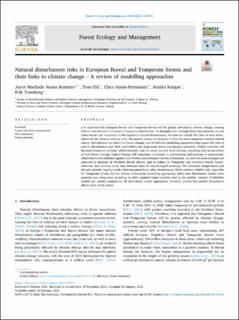| dc.description.abstract | It is expected that European Boreal and Temperate forests will be greatly affected by climate change, causing natural disturbances to increase in frequency and severity. To detangle how, through forest management, we can make forests less vulnerable to the impact of natural disturbances, we need to include the risks of such disturbances in our decision-making tools. The present review investigates: i) how the most important forestry-related natural disturbances are linked to climate change, and ii) different modelling approaches that assess the risks of natural disturbances and their applicability for large-scale forest management planning. Global warming will decrease frozen soil periods, which increases root rot, snow, ice and wind damage, cascading into an increment of bark beetle damage. Central Europe will experience a decrease in precipitation and increase in temperature, which lowers tree defenses against bark beetles and increases root rot infestations. Ice and wet snow damages are expected to increase in Northern Boreal forests, and to reduce in Temperate and Southern Boreal forests. However, lack of snow cover may increase cases of frost-damaged seedlings. The increased temperatures and drought periods, together with a fuel increment from other disturbances, likely enhance wildfire risk, especially for Temperate forests. For the review of European modelling approaches, thirty-nine disturbance models were assessed and categorized according to their required input variables and to the models’ outputs. Probability models are usually common for all disturbance model approaches, however, models that predict disturbance effects seem to be scarce. | |
